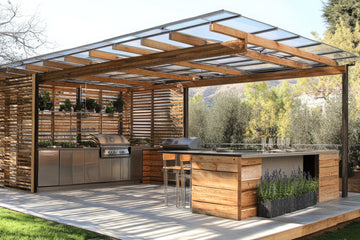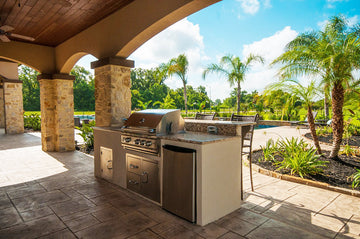Green Outdoor Kitchens: Eco-Friendly and Sustainable Design
by Kim Sheppard on Jul 03, 2025

Outdoor kitchens have become one of the most desirable additions to modern homes, offering a seamless extension of indoor living into the open air. But as more homeowners embrace the beauty and function of outdoor living, a new priority has emerged—sustainability. Creating a green outdoor kitchen isn’t just about aesthetics or convenience anymore; it’s about being environmentally responsible without sacrificing quality or comfort.
At RTF Systems, we understand that today’s homeowners want solutions that reflect their values. That’s why we specialize in outdoor kitchens that combine beautiful design with sustainable materials and practices. In this blog, we’ll walk you through how to build an eco-friendly outdoor kitchen—from smart material choices and design strategies to energy-efficient appliances and water conservation techniques. If you’re ready to transform your backyard into a stylish, sustainable haven, read on.
Why Build a Sustainable Outdoor Kitchen?
Every home improvement project has an environmental impact. Whether it’s the resources used in construction, the energy your appliances consume, or the waste generated by short-lived materials, the choices you make can either help or harm the environment. A green outdoor kitchen aims to reduce that impact by using recycled or renewable materials, energy-efficient appliances, and smart design principles that conserve resources over time.
Beyond helping the planet, sustainable kitchens also offer long-term benefits for homeowners. Eco-friendly materials often last longer and require less maintenance. Energy- and water-efficient systems reduce utility bills. And as awareness of sustainability grows, having a green kitchen may even increase your home’s resale value. In short, a green kitchen is a win for both the earth and your investment.

Choosing Eco-Friendly Materials
The foundation of any sustainable outdoor kitchen lies in the materials you use. Instead of relying on virgin resources or chemically treated woods, consider materials that are recycled, reclaimed, or renewable.
For example, recycled concrete or composite pavers make an excellent choice for flooring. These options reduce the demand for raw materials and often allow for better water drainage, preventing runoff and erosion. Reclaimed wood, sourced from old barns or shipping pallets, brings warmth and character to your space while reducing deforestation. When treated properly, reclaimed wood can withstand outdoor conditions just as well as new timber.
Another excellent option is stainless steel, particularly when it’s recycled. Stainless steel cabinetry is durable, weather-resistant, and fully recyclable at the end of its lifecycle. When powder-coated, it also reduces the release of volatile organic compounds (VOCs), making it a healthier choice for your backyard and your family.
For countertops, recycled glass surfaces are both eye-catching and environmentally sound. These countertops are typically made from crushed glass set in concrete or resin, offering a modern and resilient finish that stands up to outdoor use. If you’re looking for cabinetry that balances sustainability with visual appeal, bamboo is a standout option. It grows quickly, regenerates without replanting, and offers a sleek, natural look that complements any outdoor setting.

Smart Design for Sustainability
Eco-friendly materials are only part of the equation. How you design your outdoor kitchen plays a big role in how sustainable it truly is. Effective design reduces waste, minimizes energy use, and improves functionality—often with minimal extra cost.
One of the first things to consider is how to take advantage of passive solar design. By positioning your kitchen in a way that maximizes natural light and shade, you can reduce the need for electric lighting and mechanical cooling. For example, installing your grill in a shaded area or using a pergola with climbing plants can significantly reduce heat buildup in the summer. Orienting seating and workspaces toward sunlight ensures better visibility during daytime hours without flipping a switch.
Another overlooked factor is ventilation. Open-air layouts naturally allow smoke and heat to escape without the need for electric exhaust fans. By encouraging airflow through thoughtful positioning of appliances, counters, and walls, you reduce your reliance on electricity while keeping the space comfortable.
Modular kitchen designs are also a smart sustainability choice. Instead of building everything in place, modular components allow you to move or reconfigure your kitchen over time. This flexibility reduces waste and makes future upgrades or repairs simpler and less intrusive. Similarly, opting for a compact layout ensures you’re only building what you need—cutting down on material use without compromising performance.
Energy-Efficient Appliances for Outdoor Use
Outdoor kitchens typically include several appliances: grills, refrigerators, lighting, and sometimes dishwashers or beverage centers. All of these use energy—and often more than their indoor counterparts because they operate in less controlled environments.
To make your kitchen truly green, start by choosing Energy Star-certified appliances. These units meet strict guidelines for energy and water efficiency, helping you reduce your environmental impact without sacrificing performance. For example, an Energy Star-rated refrigerator uses up to 40% less energy than a standard model, which can add up quickly when used year-round.
If you plan to cook with electricity, induction cooktops are far more efficient than traditional electric burners or gas. They heat only when in contact with compatible cookware, which means less wasted heat and faster cooking times. For those who prefer grilling, infrared grills are a fantastic eco-conscious option. They heat up faster, use less gas, and provide even cooking—reducing food waste due to inconsistent temperatures.
Lighting is another area where sustainability can shine. Instead of wiring outdoor lights into your home’s electrical system, choose solar-powered LED fixtures. These lights charge during the day and automatically illuminate your space at night—without pulling power from the grid. Plus, LED lights last longer and consume significantly less energy than incandescent bulbs.
Conserving Water Outdoors
Water usage in outdoor kitchens may not be as high as indoors, but it’s still worth addressing—especially in areas prone to drought or water restrictions. Installing low-flow faucets or outdoor-rated dishwashers helps minimize water waste without impacting functionality.
Incorporating rainwater collection systems into your landscape design is another smart move. Collected rainwater can be used to irrigate nearby gardens, wash down countertops, or clean patio furniture. It’s an efficient, eco-friendly alternative to relying solely on city water sources.
Surrounding your outdoor kitchen with drought-tolerant landscaping can also reduce your environmental impact. Native plants require less irrigation, are more resilient to local pests, and help maintain biodiversity. For even greater efficiency, use drip irrigation systems and mulch to retain moisture and minimize evaporation.
Reducing Waste and Promoting Recycling
Building green doesn’t end with construction. A sustainable outdoor kitchen should also help reduce waste during everyday use. This starts with incorporating built-in recycling and compost stations into your cabinetry. Not only does this make sorting easy, but it also keeps your kitchen looking clean and organized.
It’s also smart to consider the packaging of the materials and appliances you choose. Work with suppliers who prioritize minimal, recyclable, or biodegradable packaging. Whenever possible, reuse or repurpose existing materials—like turning old bricks into a decorative backsplash or using reclaimed stone for counters or paths.
The more you can reuse or recycle, the less you contribute to landfills. Plus, it adds character and charm to your space, making your kitchen truly one of a kind.
Long-Term Sustainability Through Durability
Sustainability isn’t just about how green something is when it’s built—it’s also about how long it lasts. A truly eco-friendly outdoor kitchen is one that stands the test of time, minimizing the need for repairs, replacements, or remodeling down the road.
Materials like powder-coated metals, marine-grade polymer, and UV-resistant finishes are specifically designed to withstand harsh weather without fading, rusting, or warping. Natural stone countertops such as soapstone or granite provide unmatched durability while avoiding synthetic chemical treatments.
When your outdoor kitchen is built to last, it naturally becomes more sustainable. You’ll use fewer resources, generate less waste, and spend less time and money on maintenance.
Smart Technology for Greener Living
Today’s outdoor kitchens can incorporate smart technology to make eco-conscious living even easier. Smart grills that connect to your phone allow you to monitor temperatures and cooking times remotely—preventing overuse of gas or electricity. Timers and motion sensors for lighting and appliances help reduce energy consumption when your kitchen isn’t in use.
Additionally, leak detection sensors can alert you to plumbing issues before they become major problems—saving water, time, and money, and potentially costly repairs & downtime.
Technology isn’t just about convenience—it’s a powerful tool for making your outdoor space more efficient and sustainable.
Working with a Sustainable Outdoor Kitchen Builder
The best results come when you partner with a builder who shares your values. At RTF Systems, we’re passionate about designing and building custom outdoor kitchens that are not only stunning but also environmentally responsible. From selecting eco-friendly materials and appliances to incorporating smart layout designs, we help you build a kitchen that’s as sustainable as it is beautiful.
We’ll guide you through each step—offering insight into locally sourced materials, durable finishes, and layout strategies that reduce energy use while maximizing comfort and performance. Whether you want a rustic space with reclaimed wood or a sleek modern design powered by solar, we tailor your kitchen to meet your lifestyle and sustainability goals.
Are Green Outdoor Kitchens Worth the Investment?
While some sustainable materials and appliances may have higher upfront costs, they often pay for themselves in the long run. Lower utility bills, reduced maintenance, and greater longevity can make a big difference over the lifetime of your kitchen. And with growing interest in green living, a sustainable outdoor kitchen can increase your home’s resale value and marketability.
Just as important, a green kitchen reflects a commitment to living with purpose and responsibility—something you can feel good about every time you light the grill.
Final Thoughts
Creating a green outdoor kitchen is one of the most rewarding ways to elevate your backyard while caring for the environment. By choosing eco-friendly materials, designing with intention, and selecting energy-efficient appliances, you’re investing in a space that supports your family, your lifestyle, and the planet.
At RTF Systems, we’re proud to help homeowners create outdoor kitchens that reflect both beauty and sustainability. If you’re ready to take the next step, let’s build something extraordinary—together.
Schedule a consultation with RTF Systems today and discover how a sustainable outdoor kitchen can transform your home.



